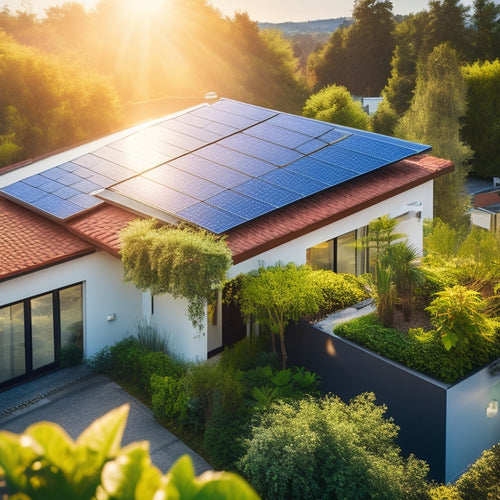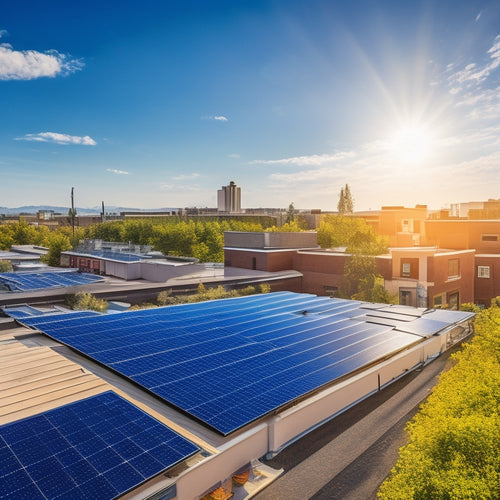
Tips for Installing Solar Panels on Office Buildings
Share
When installing solar panels on your office building, start by evaluating your building's solar readiness, considering factors like location, orientation, and shading. Determine your energy needs by reviewing past electricity bills and identifying peak usage times. Choose a system that meets your energy requirements, and select solar panels with high efficiency ratings, suitable materials, and a compatible mounting system. Ascertain electrical compatibility, comply with local building codes, and manage installation logistics efficiently. Finally, monitor your system's performance to optimize energy production. By considering these factors, you'll be well on your way to a successful installation - and there's more to investigate to maximize your solar investment.
Key Takeaways
- Conduct a solar readiness assessment to identify the best location, orientation, and shading analysis for optimal energy output.
- Determine your office building's energy needs by reviewing past electricity bills, identifying peak usage, and evaluating energy efficiency.
- Select the right solar panel system type, size, and complexity based on energy output calculation, maintenance, and warranty considerations.
- Evaluate local incentives, including tax incentives, utility rebates, state grants, financing options, and renewable energy credits to reduce costs.
- Ensure compliance with local building codes, permits, and regulations, and prepare the roof structure by assessing its integrity and load capacity.
Assessing Your Office Building
Three key factors determine your office building's solar readiness: its location, orientation, and obstructions. You'll want to evaluate these factors to guarantee your building is suitable for solar panels.
Location is essential, as it affects the amount of sunlight your building receives. Buildings in areas with high levels of sunlight will generate more power.
Roof orientation is also important, as it impacts the angle at which sunlight hits the panels. A south-facing roof with little to no shading is ideal.
You'll need to conduct a shading analysis to identify any obstructions that could affect your solar panel's performance. This includes trees, buildings, and other structures that cast shadows on your roof.
You can use software or consult with a professional to determine the best placement for your panels. By evaluating these factors, you'll be able to determine the size and type of solar panel system that's right for your building, guaranteeing you maximize your energy output and reduce your carbon footprint.
Choosing the Right System
With your office building's solar readiness assessed, you're now ready to select the ideal solar panel system. This decision is vital, as it will impact your energy savings and return on investment.
You'll need to take into account several factors, including system types, installation costs, and your energy needs.
When choosing a system, think about the following key factors:
-
System types: You can opt for a rooftop-mounted system, a ground-mounted system, or a building-integrated photovoltaic (BIPV) system. Each has its pros and cons, so it's important to assess your building's design and energy requirements.
-
Installation costs: The cost of installation varies depending on the system type, size, and complexity. Be sure to factor in the cost of inverters, mounting hardware, and labor.
-
Energy output: Calculate your building's energy needs and select a system that can meet those needs. You may want to take into account a system with a higher energy output to account for future energy demands.
-
Maintenance and warranty: Look for a system with an extensive warranty and maintenance requirements that fit your budget and schedule.
-
Local building codes and regulations: Verify the system you choose complies with local building codes and regulations to avoid any potential issues during installation or operation.
Evaluating Local Incentives
You've selected the ideal solar panel system for your office building, considering factors like system type, installation costs, energy output, maintenance, and warranty.
Now it's time to evaluate local incentives that can help offset the upfront costs. Start by researching local tax incentives, such as property tax exemptions or credits, that can reduce your tax liability.
Utility rebate programs, offered by your local utility company, can also provide a one-time rebate based on the system's energy output. Additionally, investigate state grant opportunities that can provide funding for your solar project.
Financing options, like power purchase agreements or solar loans, can also help make your project more financially viable. Community solar initiatives, which allow multiple individuals or organizations to share the benefits of a single solar array, may also be available in your area.
Moreover, consider the value of renewable energy credits, which can be sold to utilities or other companies to offset their renewable energy requirements.
Determining Energy Needs
Evaluating your office building's energy needs is crucial for determining the size and type of solar panel system required. You need to understand how much energy your building consumes and when it consumes it to guarantee you install a system that meets your power demands.
To conduct an energy consumption analysis, you'll need to gather data on your building's energy usage patterns. Here's what to take into account:
-
Review your past electricity bills to determine your average energy consumption.
-
Identify the time of day and year when your energy usage peaks.
-
Reflect on the energy efficiency of your building's lighting, HVAC, and other systems.
-
Account for any planned changes to your building's layout or operations that may impact energy consumption.
-
Use power demand forecasting tools to predict your building's future energy needs based on factors like weather patterns and occupancy rates.
Selecting a Solar Panel Type
When selecting a solar panel type, you'll need to take into account factors that impact performance, durability, and installation requirements.
You'll want to evaluate panel efficiency ratings, which range from 15% to over 20%, to determine how much energy your system can produce.
Additionally, you'll need to choose between solar cell materials, such as monocrystalline, polycrystalline, or thin-film, and decide on a mounting system option that suits your roof type and local building codes.
Panel Efficiency Ratings
Three key factors determine a solar panel's efficiency: its photovoltaic (PV) cell type, panel size, and conversion efficiency rating. When selecting a solar panel type, you'll want to take into account these factors to guarantee ideal panel performance.
To compare the efficiency of different solar panels, look for the following:
- Conversion efficiency rating: A higher rating means more energy is generated per unit area.
- Temperature coefficient: A lower coefficient means the panel performs better in high temperatures.
- Fill factor: A higher fill factor indicates a more efficient panel.
- Open-circuit voltage: A higher voltage can be beneficial for your office building's electrical system.
- Maximum power point tracking: This feature helps enhance energy production by tracking the maximum power point of the panel.
When evaluating these factors, remember that a higher efficiency rating doesn't always translate to better performance.
You'll need to take into account your office building's specific energy needs and the local climate to make an informed decision.
Solar Cell Materials
Your solar panel's photovoltaic (PV) cells are the heart of your renewable energy system, converting sunlight into electrical energy.
When selecting a solar panel type, you'll encounter different solar cell materials, each with its own advantages and disadvantages. Monocrystalline silicon cells offer high solar cell efficiency, typically above 20%, but are more expensive.
Polycrystalline silicon cells are a more affordable option, with slightly lower efficiency rates. Thin-film solar cells are cheaper still, but their efficiency rates are lower, around 10-14%.
You should also consider the solar cell lifespan when making your decision. Most solar panels come with a 25-year warranty, but some manufacturers offer up to 30 years.
Look for panels with a high temperature coefficient, as this will guarantee your system performs well in hot weather conditions. Additionally, consider the panel's durability and resistance to corrosion, as this will impact its lifespan.
Mounting System Options
Selecting the right solar panel type is just the first step in designing an efficient solar energy system.
Now, you need to evaluate the mounting system options to guarantee your solar panels are securely and effectively installed on your office building. The mounting system you choose will affect the performance, durability, and maintenance of your solar panels.
When selecting a mounting system, you have several options to evaluate:
-
Fixed mounts: Ideal for roofs with a consistent angle, fixed mounts are cost-effective and easy to install.
-
Adjustable racks: Allow for adjustments to the tilt and angle of the solar panels to enhance energy production.
-
Tracking systems: Enable the solar panels to follow the sun's movement, maximizing energy output.
-
Ballasted systems: Use weights to secure the solar panels to the roof, eliminating the need for penetration.
-
Clamped systems: Attach to the roof's seams or edges, providing a secure and waterproof installation.
Preparing the Roof Structure
The roof's structural integrity is crucial for supporting the added weight of solar panels, so it's important to evaluate its condition before installation.
You'll need to determine if your office building's roof can handle the roof load of the solar panels, which typically ranges from 2-5 pounds per square foot.
Conduct a thorough inspection to identify any signs of wear, damage, or weakness. Check for sagging, cracks, or rotten wood, and make certain the roof is securely fastened to the building.
You may want to consult with a structural engineer or roofing expert if you're unsure about the roof's condition.
Additionally, confirm that your roof's structural integrity can support the weight of the solar panels, mounting system, and any additional components. This includes the weight of snow, if you're in an area that receives heavy snowfall.
Ensuring Electrical Compatibility
When you're installing solar panels, confirming electrical compatibility is vital to avoid system malfunctions and safety hazards.
You'll need to check the system voltage to verify it matches the inverter's input voltage rating, as well as confirm that the inverter can handle the total power output of the solar panels.
System Voltage Check
During the solar panel installation process, guaranteeing electrical compatibility is essential to prevent damage to your system or even risk of electrical shock.
One critical aspect of this is the system voltage check. This check guarantees that your solar panel system operates within the voltage range specified by the manufacturer and meets the requirements of your office building's electrical infrastructure.
To guarantee system compatibility, you should:
- Verify the maximum voltage rating of your office building's electrical panel
- Check the voltage regulation of your solar panel system to guarantee it's compatible with your building's electrical infrastructure
- Confirm the system's voltage output is within the acceptable range for your building's electrical equipment
- Check for any voltage drop issues that could affect system performance
- Consult with a licensed electrician if you're unsure about any aspect of the voltage check
Panel Inverter Matching
Having verified your system's voltage compatibility, you now need to confirm that your solar panel system's inverters are properly matched to the panels themselves. This is vital to guarantee efficient energy conversion and minimize losses. Inverter matching involves selecting an inverter that complements your panel type, considering factors like efficiency, installation costs, and grid integration requirements.
| Inverter Type | Panel Type | Efficiency Comparison |
|---|---|---|
| String Inverter | Monocrystalline | 95% (inverter) vs 20% (panel) |
| Microinverter | Polycrystalline | 95% (inverter) vs 18% (panel) |
| Power Optimizer | Thin-Film | 98% (inverter) vs 12% (panel) |
| Central Inverter | Bifacial | 98.5% (inverter) vs 22% (panel) |
When selecting an inverter, consider the load calculation, performance metrics, and lifespan expectations. It's important to maintain your system with regular checks and adhere to warranty options to confirm peak performance. By matching your inverter to your panel type, you'll maximize energy production and minimize maintenance costs.
Meeting Local Building Codes
Before installing solar panels, you must guarantee compliance with local building codes and regulations, which vary by region and even municipality.
Failure to comply can result in costly fines, project delays, or even revocation of permits. To avoid these issues, research and understand the specific regulations governing your office building's location.
Some key considerations include:
-
Zoning regulations: Confirm your solar panel installation complies with local zoning laws, including setbacks, height restrictions, and lot coverage ratios.
-
Permit requirements: Obtain necessary permits from local authorities before commencing installation, including electrical, building, and plumbing permits.
-
Structural integrity: Verify that your office building's roof can support the weight of solar panels, and that the installation won't compromise its structural integrity.
-
Fire safety: Meet local fire safety codes, including clearance requirements around solar panels and access paths for firefighters.
-
Electrical connections: Comply with local electrical codes, including voltage, current, and grounding requirements.
Managing Installation Logistics
Your solar panel installation project timeline depends on efficient management of logistics, from delivery to deployment. You'll need to guarantee that all components, including panels, inverters, and mounting systems, arrive on site when they're needed.
Scheduling deliveries carefully will prevent delays and minimize storage requirements.
Coordinating contractors is another critical aspect of logistics management. You'll likely be working with multiple teams, including electricians, roofers, and solar installers. You'll need to guarantee that each team is aware of their role, responsibilities, and timelines.
Develop a detailed project schedule that outlines each phase of the installation process, including milestones and deadlines.
Effective logistics management also requires contingency planning. Identify potential risks, such as weather delays or component shortages, and develop strategies to mitigate them.
Monitoring Performance Efficiency
One key aspect of ensuring your solar panel system operates at its best is monitoring its performance efficiency. This process involves tracking the system's energy output and identifying areas for improvement.
By monitoring performance, you can detect potential issues before they become major problems, ensuring maximum energy production and minimizing downtime.
To effectively monitor your solar panel system's performance efficiency, consider the following:
- Invest in a monitoring system that provides real-time data on energy production, consumption, and system performance.
- Set up alerts for unusual patterns or drops in energy production, allowing you to quickly address any issues.
- Regularly review performance data to identify trends and opportunities for optimization.
- Compare your system's performance to industry benchmarks and manufacturer specifications.
- Use data analysis software to visualize performance data and make data-driven decisions about system maintenance and upgrades.
Frequently Asked Questions
Can I Install Solar Panels on a Leased Office Building?
You'll need to review your lease agreements to determine if installation permissions are granted, and obtain written consent from your landlord before installing solar panels on a leased office building, ensuring a successful and legally binding project.
Do Solar Panels Void the Roof's Warranty?
As you commence on utilizing the sun's energy, beware: solar panels might void your roof's warranty, but it's not a guarantee. Review the roof warranty terms and adhere to solar installation guidelines to mitigate potential risks and guarantee a harmonious coexistence of panels and roof.
Can I Sell Excess Energy Back to the Grid?
You can sell excess energy back to the grid through net metering benefits, allowing you to offset your energy consumption and reduce your bill; many utilities also offer energy buyback programs, providing credits or cash for surplus energy.
Are Solar Panels Noisy or Disruptive?
You'll find solar panels produce minimal solar noise, typically around 30 decibels, comparable to a whisper. During installation, you'll experience minor disruptions, but a well-planned installation minimizes impact, ensuring a seamless shift to renewable energy.
Do Solar Panels Attract Pests or Rodents?
You'll be thrilled to know that solar panels aren't a magnet for pests or rodents, attracting hordes of critters to your rooftop oasis. Instead, you'll find that manufacturers prioritize pest prevention and rodent control measures, ensuring a safe and efficient energy harvest.
Conclusion
You've made it! You've successfully maneuvered the complex process of installing solar panels on your office building. Now, you're about to reveal a wealth of benefits, from reduced energy bills to a sparkling green reputation. With a solar panel system that's customized to your building's unique needs, you'll be saving money and the planet in no time. In fact, you'll be generating so much clean energy, you'll be practically printing money!
Related Posts
-

Solar Power Systems for Cost-Effective Sustainability
Investing in solar power systems is a smart move for cost-effective sustainability. You can save about $1,500 annuall...
-

Long-Term Cost Savings With Solar Panels
Investing in solar panels offers substantial long-term savings on energy costs. You'll benefit from federal tax credi...
-

Solar Energy Solutions for Small Businesses
Switching to solar energy can be a game changer for your small business. You'll enjoy significant cost savings on mon...


